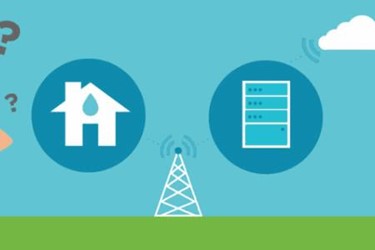Water Meter Data Management — To Sink Or SWIM (Part 1)
By Jeff Lipton, VP of Marketing and Business Development, WaterSmart Software

In part 1 of this two-part post, we look at the history of meter data management systems and how they apply to the water industry:
Water Meter Data Management: To sink or SWIM?
The role of a Meter Data Management System (MDMS) is not well defined within the water industry. Many products on the market claim to provide MDM functionality, but few people understand the value of what these systems offer. To understand how this confusion has come about and what can be done to address data management needs in the water industry, we need to first examine the evolution of MDM within a System for Water Information Management (SWIM).
A Brief History of the MDMS
In the late 1990s, the electric industry pioneered the concept of Advanced Metering Infrastructure (AMI), recognizing a need for more frequent and accurate meter data. However, this emerging meter information occasionally delivered anomalistic or missing data, and an MDMS was designed to manage and clean the incoming flood of data.
Electricity metering can capture detailed measurements, rate features, net metering, and other structured tariffs. Over time, electric MDM solution providers have added tools to clean and process incoming metering data, now known as “VEE”: validation, estimation, and editing. This system catches data anomalies and flags them for further analysis or remediation, where either computer programs or users can intervene to “edit” the data before it becomes “data of record.” VEE can also automatically synthesize missing read data.
While MDMs don’t technically need to be dedicated systems, electric utilities have unique considerations that have contributed to the evolution of the MDMs as standalone systems, distinct from an AMI platform.
This is the result of electric utilities needing to track large volumes of data associated with hundreds or even millions of meters, as well as sync with other smart devices (part of the concept of the “smart grid”). Additionally, given the scale of a typical electric utility, there can be multiple metering technologies in place at any given time. Having a central independent data repository for the management and dissemination of all this disparate metering data is the only rational solution in the face of such complexity.
The Elusive Water MDM
The water industry has, unsurprisingly, yet to embrace the concept of an MDM in its original (i.e., electric-specific) form. While many consultants talk about MDMs, and we often see language in AMI RFPs referencing MDMs, the majority of true MDM capabilities are not beneficial to water utilities, and the major challenges presented by a true MDM are nearly insurmountable for small agencies.
Benefit and Challenge 1: Multi-vendor and multi-technology support
MDMs centralize and normalize metering data from multiple systems for electricity utilities. Electric utilities typically cover large service areas, requiring different technologies depending on geography. For example, RF based AMI may work in urban or suburban areas, whereas rural locations may require a programmable logic controller (PLC), cellular or manual/AMR reading. Water utilities, conversely, tend to be much smaller and do not typically implement multiple technologies to cover their local territories. In the rare instance when they do, they often utilize technology from a common vendor.
Electric utilities also want an independent source for meter data ownership. An MDM often functions as a data bus, shepherding normalized information between various systems. Its replacement is challenging due to the number of systems typically reliant on it. Consequently, electric utilities typically implement 3rd party MDM solutions from major providers like Oracle or SAP rather than from the metering vendors themselves. In many cases, the metering vendors do not even offer full MDM functionality, so using an independent solution provides the most flexibility in selecting an AMI network provider.
Most water utilities integrate AMI with their billing software and call it a day; no MDM required. They generally push the metering vendors to add some MDM “lite” functionality into their AMI head-end systems such as longer-term storage (up to 2 years max), billing file export, basic reporting, and 3rd party APIs. However, this approach has downsides. It means a high risk of vendor lock-in and because both the MDM and the head-end system are conjoined, the MDM functionality is often limited. Also, many utilities wish to keep their data for much longer than 2 years, yet almost no head-end systems support more than 13 to 24 months of storage.
(In part 2 of this post, we review additional benefits and challenges of an MDM and what ideal technology solution best suits water industry needs.)
About the author:
 Jeff manages WaterSmart Software’s go-to-market strategy development and marketing campaign activities, along with sales operations support. Prior to WaterSmart, Jeff managed channel development and regional field marketing for EnerNOC, an international leader in energy intelligence software and demand response solutions. He joined EnerNOC from Coyle Industries, where he pioneered the development of renewable distributed generation solar power systems for military, developing world, and other off-grid electrical applications. Jeff previously spent a decade in the digital media industry where he held various product management, marketing, and executive sales positions. Jeff began his career as a commercial audio recording engineer and producer. Jeff earned a Master of Business Administration from the Haas School of Business at the University of California. He also received a BA in Political Science from the University of Colorado where he was elected Phi Beta Kappa and graduated Magna Cum Laude.
Jeff manages WaterSmart Software’s go-to-market strategy development and marketing campaign activities, along with sales operations support. Prior to WaterSmart, Jeff managed channel development and regional field marketing for EnerNOC, an international leader in energy intelligence software and demand response solutions. He joined EnerNOC from Coyle Industries, where he pioneered the development of renewable distributed generation solar power systems for military, developing world, and other off-grid electrical applications. Jeff previously spent a decade in the digital media industry where he held various product management, marketing, and executive sales positions. Jeff began his career as a commercial audio recording engineer and producer. Jeff earned a Master of Business Administration from the Haas School of Business at the University of California. He also received a BA in Political Science from the University of Colorado where he was elected Phi Beta Kappa and graduated Magna Cum Laude.
